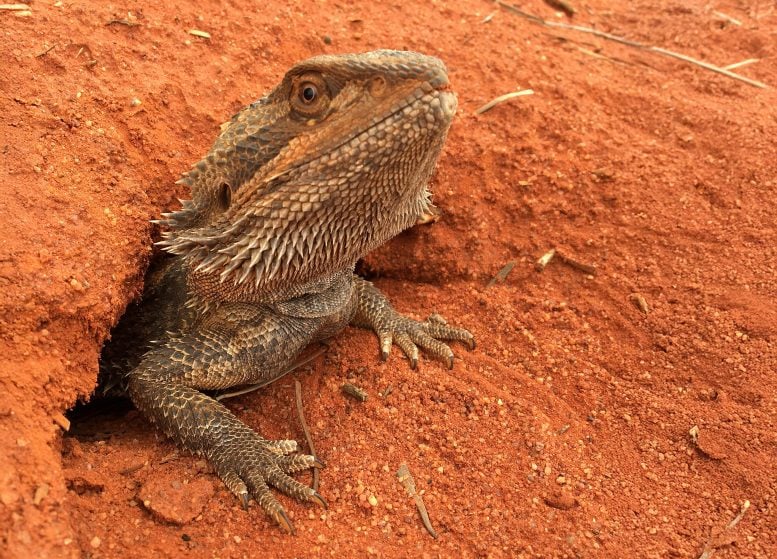Scientists have finally cracked one of the strangest mysteries in reptile biology: how bearded dragons decide their sex.
Breakthrough Genomes Reveal Bearded Dragon’s Secrets
Two separate research teams have now released near-complete reference genomes of the central bearded dragon (Pogona vitticeps), a lizard species that ranges widely across central eastern Australia and is also a favorite pet in Europe, Asia, and North America.
What makes this reptile stand out is its unusual system of sex determination: whether it develops as male or female depends not only on its chromosomes but also on the temperature at which its eggs are incubated. Because of this dual mechanism, the species has long served as a model for studying how sex is determined in animals.
With major advances in genome sequencing, scientists have finally pinpointed a specific region of the genome and identified a likely master sex-determining gene tied to male development. The fact that two independent groups reached this conclusion using different methods gives the discovery much greater weight.
In bearded dragons, both genetic and environmental influences shape sex. Unlike most species, where sex is set entirely by chromosomes, these lizards can override genetics under certain conditions. When eggs carrying male chromosomes are exposed to high incubation temperatures, the hatchlings can develop into fully functional females.
Unraveling the Z and W Chromosomes
Like many reptiles and birds, bearded dragons use a ZZ/ZW system of sex chromosomes: males have two matching ZZ chromosomes, while females have one Z and one W. The situation becomes more complex because ZZ individuals that are genetically male can still become females if incubated at warm enough temperatures, without relying on the W chromosome or its associated genes.
Recent progress in ultra-long nanopore sequencing has made it possible to assemble the sex chromosomes from telomere to telomere (T2T) and clearly identify the regions that do not recombine. This makes it much easier to narrow down the list of possible sex-determining genes. The technology also allows researchers to better distinguish the maternal and paternal versions of the genome, enabling direct comparisons of the Z and W chromosomes to detect gene loss or functional differences that could explain how sex is controlled in the species.

Two Teams, Two Technologies, One Discovery
The first paper from researchers from BGI, Chinese Academy of Sciences and Zhejiang University, uses DNBSEQ short-reads combined with long-reads from the new CycloneSEQ nanopore sequencer, this being the first animal genome published using this technology. Generation of the second genome was led by researchers from the University of Canberra with funding from Bioplatforms Australia, the Australian Research Council and PacBio Singapore, and with contributions to analyses from researchers of the Australian National University, Garvan Institute for Medical Research, University of New South Wales and CSIRO alongside Universitat Autònoma de Barcelona (UAB) in Spain. This assembly uses PacBio HiFi, ONT ultralong reads and Hi-C sequencing.
Having reference genomes published using these two different technologies allows a like-for-like comparison between the ONT and CycloneSEQ technologies for the first time. Both technologies also complement each other by investigating the sex determination question using different approaches.
The first genome sequenced a ZZ male central bearded dragon to characterize the whole Z sex chromosome for the first time while the second assembled the genome of a female ZW individual. The new nanopore sequencer also enabled the recovery of around 124 million base pairs of previously undescribed and missing sequences (nearly 7% of the genome), which included numerous genes and regulatory elements to better elucidate the complicated sex determination system.
Pinpointing the Master Sex Gene
Both projects assembled 1.75 Gbp genome assemblies of exceptionally high quality to assemble all but one of the telomeres, and only a few gaps remained mostly located in the microchromosomes. Using this data showed the Z and W specific sex chromosomes were assembled into single scaffolds, and a “pseudo-autosomal region” (PAR) where the sex chromosomes pair and recombine was also detected on chromosome 16.
The sequencing of the male dragon by the BGI team looked for genes specific to Z but not the W chromosomes, and Amh and Amhr2 (the Anti-Müllerian hormone gene and its receptor) plus Bmpr1a were determined as strong candidates for the sex determining genes in this species. The sequencing of the female dragon by the Australian-led team pinpointed to the same candidate Sex Determination Region (SDR) of their dragon genome, and also highlighted Amh and Amhr2 as the likely candidate genes.
Studying the expression in different developmental stages found Amh had significant male-biased expression patterns making it the most likely candidate as the master sex-determining gene. The differential expression of another sex-related gene Nr5a1 in the PAR suggests that the story may be more complicated, as Nr5a1 encodes a transcription factor with binding sites on the Amh promoter region.
Unlike many fish that enlist Amh-like genes in sex determination, the autosomal copies of Amh and its receptor gene Amhr2 remain intact and functional. It could be that sex is determined by some form of caucus among genes on the sex chromosomes of the bearded dragon moderated by their residual autosomal copies.
A Landmark Find: Amh Emerges as Candidate
The main highlight of these assemblies is therefore the discovery of genetic elements central to male sexual differentiation in vertebrates, on the sex chromosomes. The genes Amh and those coding its receptor AMHR2 have been copied to the Z chromosome in the non-recombining region, and so are obvious candidates for the master sex determining gene working via a dosage-based mechanism in this species, a discovery that has eluded discovery for so many years. No master sex determining gene akin to Sry in mammals or Dmrt1 in birds has to date been discovered in any reptile species. This new work provides a clear candidate in Amh, which is present in double dose in the ZZ male and single dose in the ZW female.
Arthur Georges from University of Canberra and senior author on the second paper says on the utility of this work: “We anticipate accelerated research in other areas arising from these newly available assemblies, such as cranial development, brain development, behavioural studies, gene-gene and gene-environment interactions in comparative studies of vertebrate sex determination and in many other areas looking for a well-supported squamate model against which to compare with their model species be it mouse, human or bird.”
China’s Rapid Rise in Genome Technology
“I never cease to be amazed by the rapidity of progress of Chinese science. In relatively few years, BGI and its companion enterprises have developed sequencing technologies that deliver outcomes as good, and throughput and cost effectiveness that is better, than competing technologies on the market. These genome assemblies are testimony to that level of achievement.”
Qiye Li from BGI and senior author on the first paper Lead author of the Chinese project explains their rationale for using this approach: “We decided to start working on the bearded dragon genome last year as the first animal genome for this new sequencer because it was the Year of the Dragon in China. Benefiting from the unbiased long-reads provided by the CycloneSEQ sequencer, we readily obtained a highly contiguous genome assembly and resolved highly repetitive and high-GC regions that were traditionally challenging for assembly. The two reference genomes, derived from opposite sex and generated by different technologies, are indeed complementary to each other. I am excited that both genomes pinpoint the key role of AMH signaling in sex determination in this species. But how did the sex chromosomes arise? We anticipate that additional high‑quality genomes from related species will further elucidate the evolutionary origin of the ZW system and complete the story.”
Confidence Strengthened by Independent Proof
Having two separate projects finding the same key candidate master genes independently of each other greatly increases the confidence in these findings. And openly sharing all of the data allows others to build upon this work, especially as the exact role of some of the other contributing transcription factors linked to sex determination is not yet fully resolved. The generation of these two new high quality genome assemblies however, is a massive step forward towards understanding the complete story of sex determination in this species.
References:
“A near-complete genome assembly of the bearded dragon Pogona vitticeps provides insights into the origin of Pogona sex chromosomes” by Qunfei Guo, Youliang Pan, Wei Dai, Fei Guo, Tao Zeng, Wanyi Chen, Yaping Mi, Yanshu Zhang, Shuaizhen Shi, Wei Jiang, Huimin Cai, Beiying Wu, Yang Zhou, Ying Wang, Chentao Yang, Xiao Shi, Xu Yan, Junyi Chen, Chongyang Cai, Jingnan Yang, Xun Xu, Ying Gu, Yuliang Dong and Qiye Li, 19 August 2025, GigaScience.
DOI: 10.1093/gigascience/giaf079
“A near telomere-to-telomere phased genome assembly and annotation for the Australian central bearded dragon Pogona vitticeps” by Hardip R Patel, Kirat Alreja, Andre L M Reis, J King Chang, Zahra A Chew, Hyungtaek Jung, Jillian M Hammond, Ira W Deveson, Aurora Ruiz-Herrera, Laia Marin-Gual, Clare E Holleley, Xiuwen Zhang, Nicholas C Lister, Sarah Whiteley, Lei Xiong, Duminda S B Dissanayake, Paul D Waters and Arthur Georges, 19 August 2025, GigaScience.
DOI: 10.1093/gigascience/giaf085
Never miss a breakthrough: Join the SciTechDaily newsletter.
